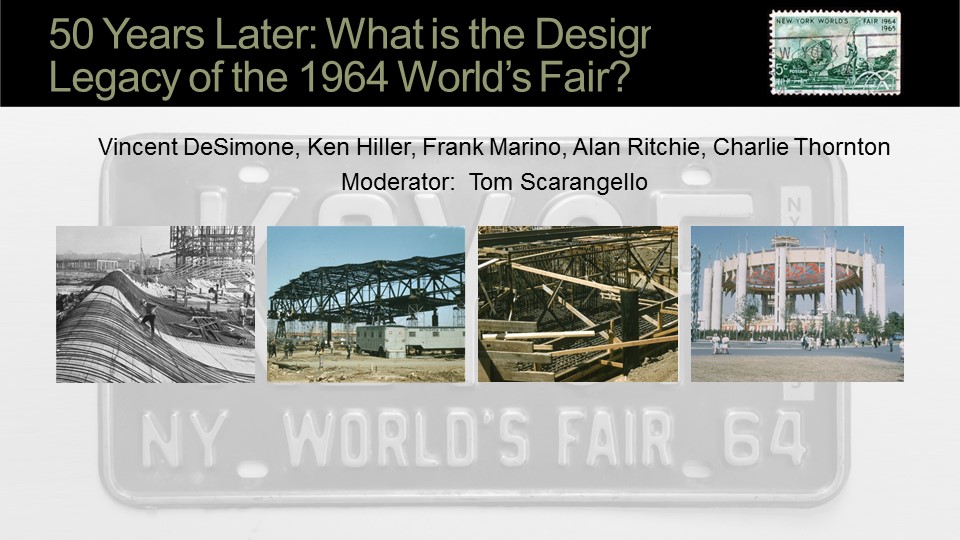by Claire Webb
Four of the key engineers who worked on 1964 World’s Fair in NYC gathered on 05.07.14 to reflect on the burst of creativity and daring of that time, and how the industry has changed in the past 50 years. Vincent DeSimone, PE, FACI, FASCE, chairman of DeSimone Consulting Engineers; Ken Hiller, PhD, PE, FASCE, former vice president and chief engineer at Bovis; Frank Marino, director of operations at Seismic Structural Design Associates; Alan Ritchie, AIA, principal at Philip Johnson Alan Ritchie Architects; and Charles Thornton; PhD, Hon. AIA, PE, Hon. ASCE, chairman of Charles H. Thorton & Company, were all very young when they worked under lead architect Lev Zetlin; they had all gone to Manhattan College, where Zetlin taught, and bonded over working for a “brilliant but difficult” man. There was clearly a “seat-of-the pants feeling” as the young, ambitious men dove headfirst into this huge project that has become a New York icon. “If you would have told me that Men in Black would have been at the Fair…,” DeSimmone chuckled.
In 1961, all four men had kids when they started working for $98 a week. As young men, the posse all spoke of the sense of “newness and wonderfulness” that the 1960s seemed to ooze. The flavor of possibility, they said, gave them the tools to build grand, unusual structures. And they did this with simple means. “We solved engineering equations by hand, and all we had was a crank calculator,” Marino recalled. He was in charge of the famous New York Pavilion, and had to work out how to construct an ellipse (circles are much easier).
All the men reminisced about how easy it was to build things back then; they conceded that environmental considerations are good things, of course, but they now miss the freedom of just going ahead and building. Hiller remarked that in the ‘60s, there were only a few consultants, making the process much more streamlined. Marino said that they felt like they could build structures that weren’t economical: “Engineering-wise, they were not efficient, but architecturally, they were beautiful.”
The men mused on what we can learn today from those sparks of innovation 50 years ago. While we can never re-create the mood of that time, or go back to an environment that was more free-wheeling, the group offered a few solid suggestions. DeSimmone bemoaned the sometimes tensioned-filled relationships between the architects, engineers, and contractors; he said that construction administration should be left up to the contractor. Thorton said that more firms should follow a design-build model, perhaps triggering more freedom and therefore greater creativity.
Event: 50 Years Later: What is the Design Legacy of the 1964 World’s Fair?
Location: Center for Architecture, 05.07.14
Speakers: Vincent DeSimone, PE, FACI, FASCE, Chairman, DeSimone Consulting Engineers; Ken Hiller, PhD, PE, FASCE, Vice President & Chief Engineer, Bovis (retired); Frank Marino, Director of Operations, Seismic Control Design Associates; Alan Ritchie, AIA, Principal, Philip Johnson Alan Ritchie Architects; Charles Thornton, PhD, Hon. AIA, PE, Hon. ASCE, Chairman, Charles H. Thornton & Company; and Tom Scarangello, PE, Chairman & CEO, Thornton Tomasetti (moderator)
Organizers: Thornton Tomasetti
